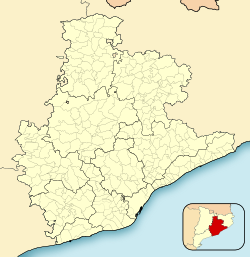
Back Piera AN بايرا (برشلونة) Arabic Piera AST پیرا AZB Piera Catalan Пьера CE Piera (munisipyo) CEB Piera German Piera DIQ Piera Spanish
Piera | |
|---|---|
 City hall | |
| Coordinates: 41°31′20″N 1°44′58″E / 41.52222°N 1.74944°E | |
| Country | |
| Community | |
| Province | Barcelona |
| Comarca | Anoia |
| Government | |
| • Mayor | Jordi Madrid Roca (2015)[1] |
| Area | |
| • Total | 57.2 km2 (22.1 sq mi) |
| Elevation | 324 m (1,063 ft) |
| Population (2018)[3] | |
| • Total | 15,362 |
| • Density | 270/km2 (700/sq mi) |
| Demonym(s) | Pierenc, pierenca |
| Website | www |
Piera (Catalan pronunciation: [piˈeɾə]) is a municipality that covers a large portion of the southeastern corner of the comarca of Anoia in Catalonia, Spain, on the left bank of the Anoia river. The agricultural land, mostly non-irrigated, is used for the cultivation of cereals, grapes, olives and almonds. The town itself hosts a number of light industries: textiles, plastics and construction materials. Tourism during the summer months is also relatively important for the local economy.
The FGC railway line R6 from Martorell and Barcelona to Igualada runs through the town, while local roads lead to Capellades and Sant Sadurní d'Anoia.
Notable monuments include the castle of Fontanet. The castle which was restored in 1916 by Ramon de Viala d'Aiguavives, Baron of Almenar is documented in 955 a.c. and now used for private functions.
The sister of the Baron of Almenar, Isabel de Viala d'Aiguavives also financed and patroned the modernist church of Ca n'Aguilera which was donated to Barcelona's Bishop by Zaragoza de Viala family in 1921. The architect of Ca N'Aguilera modernist church is Francesc Berenguer i Mestres, who was Antoni Gaudi's disciple and personal friend.
Another Piera relevant monument is the church of Santa Maria, with both Gothic and Roman elements.
- ^ "Ajuntament de Piera". Generalitat of Catalonia. Retrieved 2015-11-13.
- ^ "El municipi en xifres: Piera". Statistical Institute of Catalonia. Retrieved 2015-11-23.
- ^ Municipal Register of Spain 2018. National Statistics Institute.


